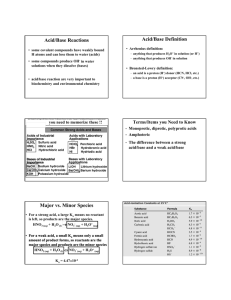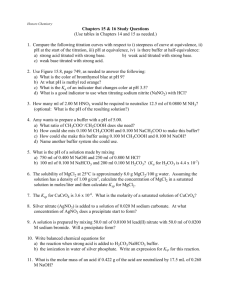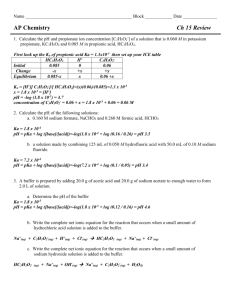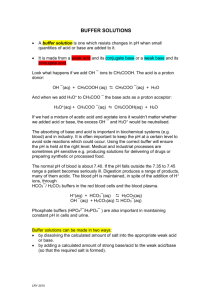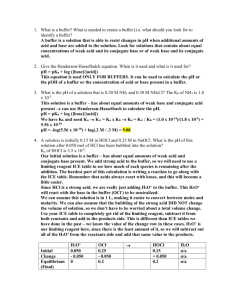Chapter 16 Additional Aqueous Equilibria Buffer Solutions Buffer
advertisement
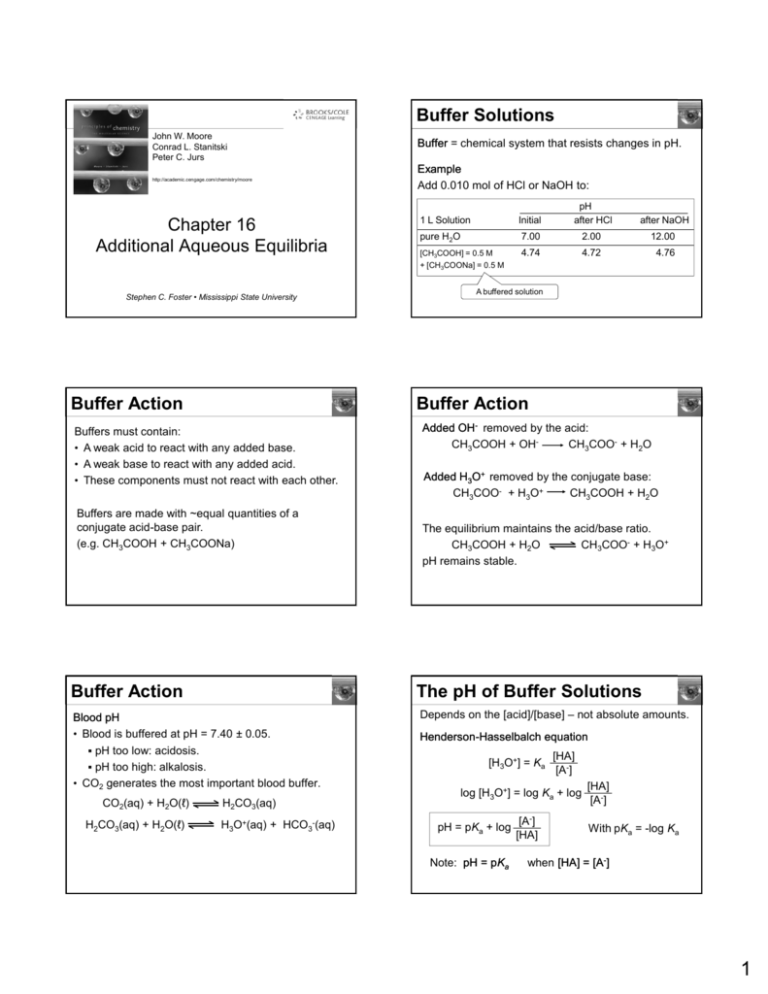
Buffer Solutions John W. Moore Conrad L. Stanitski Peter C. Jurs http://academic.cengage.com/chemistry/moore Chapter 16 Additional Aqueous Equilibria Stephen C. Foster • Mississippi State University Buffer Action Buffers are made with ~equal quantities of a conjugate acid-base pair. (e.g. CH3COOH + CH3COONa) Buffer Action 1 L Solution Initial pH after HCl after NaOH pure H2O 7.00 2.00 12.00 [CH3COOH] = 0.5 M + [CH3COONa] = 0.5 M 4.74 4.72 4.76 A buffered solution Added OH- removed by the acid: CH3COOH + OHCH3COO- + H2O Added H3O+ removed by the conjugate base: CH3COO- + H3O+ CH3COOH + H2O The equilibrium maintains the acid/base ratio. CH3COOH + H2O CH3COO- + H3O+ pH remains stable. The pH of Buffer Solutions Blood pH • Blood is buffered at pH = 7.40 ± 0.05. pH too low: acidosis. pH too high: alkalosis. • CO2 generates the most important blood buffer. H2CO3(aq) + H2O(ℓ) Example Add 0.010 mol of HCl or NaOH to: Buffer Action Buffers must contain: • A weak acid to react with any added base. • A weak base to react with any added acid. • These components must not react with each other. CO2(aq) + H2O(ℓ) Buffer = chemical system that resists changes in pH. H2CO3(aq) H3O+(aq) + HCO3-(aq) Depends on the [acid]/[base] – not absolute amounts. HendersonHenderson-Hasselbalch equation [H3O+] = Ka [HA] [A-] log [H3O+] = log Ka + log pH = pKa + log Note: pH = pK pKa [A-] [HA] [HA] [A-] With pKa = -log Ka when [HA] = [A-] 1 The pH of Buffer Solutions Common Buffers What is the pH of a 0.050 M (monoprotic) pyruvic acid + 0.060 M sodium pyruvate buffer? Ka = 3.2 x 10-3. pH weak acid weak base Ka(weak acid) pKa 4 lactic acid lactate ion 1.4 x 10-4 3.85 5 acetic acid acetate ion 1.8 x 10-5 4.74 6 carbonic acid hydrogen carbonate ion 4.2 x 10-7 6.38 = 2.49 + 0.08 7 dihydrogen phosphate hydrogen phosphate ion 6.2 x 10-8 7.21 = 2.57 8 hypochlorous acid hypochlorite ion 3.5 x 10-8 7.46 9 ammonium ion ammonia 5.6 x 10-10 9.25 carbonate ion 4.8 x 10-11 10.32 pH = – log(3.2 x 10-3) + log(0.060/0.050) What is the HPO42-/H2PO4- ratio in blood at pH =7.40. Ka(H2PO4- ) = Ka,2(H3PO4) = 6.2 x 10-8. 7.40 = −log(6.2 x 10-8) + log([HPO42-]/[H2PO4-]) log([HPO42-]/[H2PO4-]) = 0.192 [HPO42-]/[H2PO4-] = 1.5 Addition of Acid or Base to a Buffer 1.0 L of buffer is prepared with [NaH2PO4] = 0.40 M and [Na2HPO4] = 0.25 M. Calculate the pH of: (a) the buffer (b) after 0.10 mol of NaOH is added. Ka (H2PO4-) = 6.2 x 10-8 pH = pKa + log [A-] [HA] pH = 7.21 + log 0.25 = 7.01 0.40 Buffer Capacity The amount of acid (or base) that can be added without large pH changes. [A-]/[HA] determines the buffer pH. Magnitude of [A-] and [HA] determine buffer capacity The buffer capacity for: • Base addition = nconjugate acid • Acid addition = nconjugate base Useful buffer range: pH = pKa ±1 (10:1 or 1:10 ratio of [A-]/[HA]). Addition of Acid or Base to a Buffer 1.00 L Buffer: [NaH2PO4]= 0.40 M ; [Na2HPO4] = 0.25 M. (b) calculate pH after 0.10 mol of NaOH is added. Ka (H2PO4-) = 6.2 x 10-8 (b) 0.10 mol of NaOH, converts conj. acid to base: H2PO4- + OH0.40 0.10 (0.40 – 0.10) 0 ninitial nadded nafter pKa = -log(6.2 x 10-8) = 7.21 (a) No base added: 10 hydrogen carbonate pH = pKa + log [A-] [HA] → HPO42- + H2O 0.25 (0.25 + 0.10) Use n directly. [ ] = n/ V and V is the same for both (cancels) pH = 7.21 + log 0.35 = 7.28 0.30 Acid-Base Titrations • Standard solution (titrant titrant) is added from a buret. • The equivalence point occurs when a stoichiometric amount of titrant has been added. • Use a pH meter. • An indicator is used to find an end point. point • Color change observed. • End point ≠ equivalence point (should be close...). ntitrant = nanalyte ntitrant = Vtitrant [titrant] nanalyte= Vanalyte[analyte] 2 Detection of the Equivalence Point Acid-Base Indicator = weak acid that changes color with changes in pH. HIn(aq) + H2O(ℓ) color 1 H3O+(aq) + In-(aq) color 2 Observed color will vary (depends on [HIn] and [In-] in solution). Ka = Detection of the Equivalence Point The acidic form dominates when the [HIn] >> [In-] If pH = pKa -1 Basic color shows when [In-] >> [HIn] [In-] = 10 [HIn] Ka = - pKa = 1 - pH Detection of the Equivalence Point [H3O+][In-] [H3O+] = [HIn] 10 Ka = - pKa = - pH - 1 If [H3O+][In-] [HIn] [HIn] = 10 [In-] [H3O+][In-] = 10 [H3O+] [HIn] pH = pKa +1 Titration of Strong Acid with Strong Base AcidAcid-base titration curve = plot of pH vs Vtitrant added. Titrate 50.0 mL of 0.100 M HCl with 0.100 M NaOH Red pH ≤ 4 Yellow pH ≥ 6 Initial pH = -log(0.100) = 1.000 (fully ionized acid) Moles of acid = 0.0500 L Methyl Red Bromothymol blue Phenolphthalein 0.100 mol L = 5.00 x 10-3 mol Titration of Strong Acid with Strong Base Titration of Strong Acid with Strong Base After 40.0 mL of base added (before equivalence) Base removes H3O+ : H3O+ + OH2 H2O After Equivalence (50.2 mL added) All acid consumed. original nacid – total nbase added [H3O+] = Vacid (ℓ) + Vbase added (ℓ) -3 -3 [H3O+] =(5.00 x 10 – 4.00 x 10 ) mol= 0.0111 M (0.0500 + 0.0400) L pH = -log(0.0111) = 1.95 At Equivalence (50.0 mL added) All acid and base react. Neutral salt. pH = 7.00. nOH- added = 0.0502 L 0.100 mol = 5.02 x 10-3 mol L original nacid = 0.0500 L 0.100 mol L = 5.00 x 10-3 mol nOH- remaining = 0.02 x 10-3 mol Vtotal = (0.0500 + 0.0502) L = 0.1002 L pOH = - log(0.02 x10-3 / 0.1002) = 3.70 pH = 14.00 – 3.70 = 10.30 3 Titration of Strong Acid with Strong Base Vtitrant/mL Vexcess/mL Vtotal/mL [OH-]/mol L-1 Titration of Strong Acid with Strong Base pH 50.0 0 100.0 0 7.00 50.1 0.1 100.1 0.0001 10.00 50.2 0.2 100.2 0.0002 10.30 51 1 101.0 0.0010 11.00 55 5 105.0 0.0048 11.67 60 10 110.0 0.0091 11.96 70 20 120.0 0.0167 12.22 80 30 130.0 0.0200 12.30 0.1 mL of base increased the pH by 3 units! Titration of Weak Acid with Strong Base Titration of Weak Acid with Strong Base More complicated. • Weak acid is in equilibrium with its conjugate base. Example Titrate 50.0 mL of 0.100 M acetic acid with 0.100 M NaOH. What is the pH after the following titrant additions: 0 mL, 40.0 mL, 50.0 mL, and 50.2 mL? 40.0 mL added 0 mL added HA + H2O Ka = 1.8 x 10-5 = 2 [H3O+][A-] ≈ x [HA] (0.100) 50 mL of 0.100 M ninitial nadded nleft HA(aq) + OH-(aq) + H2O(ℓ) 0.00500 0.00400 0.00100 0.00400 Each OH- removes 1 HA… nleft = 0.00500 - 0.00400 H3O+ + A- A-(aq) …and makes 1 A40 mL of 0.100 M x= 0.0013 Vtotal = (50.0 + 40.0) mL = 90.0 mL = 0.0900 L pH = -log(0.0013) = 2.88 Titration of Weak Acid with Strong Base Titration of Weak Acid with Strong Base 40.0 mL added (c) 50.0 mL added Equivalence. All HA is converted to A-. Henderson-Hasselbalch: pH = -log(1.8 x 10-5) + log [A-] = nA-/ V (0.00400/0.0900) (0.00100/0.0900) [HA] = nHA/ V HA(aq) + OH-(aq) ninitial nadded nleft A-(aq) + H2O(ℓ) 0.00500 0.00500 0 0.00500 Note: V cancels (could be omitted) pH = 4.74 + log 0.0400 = 5.34 0.0100 Vtotal= 100.0 mL, so [A-] = 0.00500 mol/0.100 L = 0.0500 M A- is basic! 4 Titration of Weak Acid with Strong Base Titration of Weak Acid with Strong Base Use Kb to solve for the [OH-] generated by [A-]: (c) 50.2 mL added 0.2 mL of “extra” OH- dominates pH. Ignore any contribution from A-. Kb = [OH-][HA] [A-] A+ (0.0500 - x) Kb = Kw / Ka = 5.6 x 10-10 H2 O Kb = 5.6 x 10-10 ≈ pOH = 5.28 HA x x2 0.0500 + OHx x = 5.3 x 10-6 M [OH-] = (0.0002 L x 0.100 mol/L) / 0.1002 L = 2.0 x 10-4 M pOH = 3.7 pH = 14.0 – 3.7 = 10.3 pH = 14 - pOH = 8.72 Titration of Weak Acid with Strong Base Titration of Weak Base with Strong Acid Titrate of 50.0 mL of 0.100 M acetic acid with 0.100 M NaOH. Volume of 0.100 M HCl added (mL) pH = pKa at 50% titration (25 mL) pKa (acetic acid) = 4.74. Short vertical section compared to strong acid/strong base. Solubility Equilibria and KSP Some ionic compounds are slightly water soluble. Saturation occurs at low concentration. AgCl(s) 50.0 mL of 0.100 M ammonia titrated with 0.100M HCl. • pH = pKa at 50% to equivalence (pKa = 9.25). Solubility Equilibria and KSP Example Ksp(AgCl)=1.8 x 10-10. Calculate the solubility (mol/L). Ag+(aq) + Cl-(aq) Ksp = [Ag+][Cl-] = 1.8 x 10-10 The solubility product constant is: Ksp = [ Ag+] [ Cl-] At equilibrium, [Ag+] = [Cl-] = S Then: 1.8 x 10-10 = (S)(S) = S2 S = 1.3 x 10-5 M As always, [ ] of solid is omitted Solubility = 1.3 x 10-5 mol/L. 5 Factors Affecting Solubility Common Ion Effect pH and Dissolving Slightly Soluble Salts Using Acids Insoluble salts containing anions of Bronsted-Lowry bases dissolve in acidic solutions. AgCl is slightly soluble in water: Ca2+(aq) + CO32- (aq) Ksp = 8.7 x 10-9 Pure water: CaCO3(s) Acid: Add more Ag+ or Cl-. Equilibrium will move left. Called the common ion effect. CO3 HCO3 Ag+(aq) + Cl-(aq) AgCl(s) -(aq) 2-(aq) + H3 + H3 O+(aq) O+(aq) H2CO3(aq) HCO3 -(aq) + H2O(ℓ) H2CO3(aq) + H2O(ℓ) CO2(g) + H2O(ℓ) K ≈ 105 e.g. AgCl is less soluble in a NaCl solution than in water. The “common ion” is Cl-. Solubility and the Common Ion Effect Solubility and the Common Ion Effect Example Calculate the solubility of PbI2 in (a) water (b) 0.010 M NaI. Ksp (PbI2) = 8.7 x 10-9. (b) NaI supplies I - lowering the PbI2 solubility. (a) Pure water: Pb2+ S PbI2 + 2 I2S PbI2 [ ]initial (from NaBr) [ ]change (from PbBr2) [ ]equil Pb2+ 0 S S + 2 I0.010 2S 0.010 + 2S Ksp = 8.7 x 10-9 = [Pb2+][I -]2 = S(2S + 0.010)2 Ksp = [Pb2+][I -]2 = (S)(2S)2 = 4S3 = 8.7 x 10-9 S = 1.3 x 10-3 M Assume S << 0.010 8.7 x 10-9 ≈ S(0.010)2 S = 8.7 x 10-5 M ≈ 15 times lower than in (a) Complex Ion Formation Complex Ion Formation Metal ions (Lewis acids) can react with Lewis bases. Complex ion solubility can be evaluated using the formation constant, constant Kf. Example AgBr(s) + 2S2O32-(aq) Ag(S2O3)23-(aq) + Br -(aq) AgBr(s) Ag+(aq) + 2 S2O32-(aq) The complex is much more soluble than AgBr. Black & white photography net AgBr(s) + 2 S2O32-(aq) Knet = KspKf = [Ag+][Br -] Ag+(aq) + Br -(aq) Ag(S2O3)23-(aq) Ag(S2O3)23-(aq) + Br -(aq) [Ag(S2O3)23- ] [Ag(S2O3)23- ][Br -] = [Ag+][S2O32-]2 [S2O32-]2 light AgBr in film Ag(s) “Fix” a negative: complex and dissolve unexposed Ag salts. Ksp = 3.3 x10-13, Kf = 2 x 1013, so Knet = 7 The reaction is favored. 6 Amphoterism Precipitation: Will It Occur? Calculate Q, compare it to Ksp. If Q > Ksp • Q must decrease. • remove ions, precipitate solid. If Q = Ksp • at equilibrium (saturated solution). If Q < Ksp • Q must increase. • dissolve more solid (if present). Form more ions. Precipitation: Will It Occur? Precipitation: Will It Occur? Mix 25.0 mL of 0.0025 M HCl and 10.0 mL of 0.010 M AgNO3. Will AgCl precipitate? Ksp (AgCl) = 1.8 x 10-10. Slowly add HCl(aq) to a solution that is 0.010 M in Cu+ and 0.500 M in Pb2+. Which salt will precipitate first? Ksp for PbCl2 and CuCl are 1.7 x 10-5 and 1.9 x 10-7. nCl- = 0.0250 L (0.0025 mol/L) nAg+ = 0.0100 L (0.010 mol/L) = 6.25 x 10-5 mol = 1.0 x 10-4 mol CuCl: KSP= 1.9 x 10-7 = [Cu+][Cl-] = 0.010[Cl-] Vtotal = (0.0250 + 0.0100) = 0.0350 L. [Cl-] = 6.25 x 10-5 mol/ 0.0350 L = 1.79 x 10-3 mol/L [Ag+] = 1.0 x 10-4 mol / 0.0350 L = 2.86 x 10-3 mol/L Q = [Ag+][Cl-] = (1.79 x 10-3)(2.86 x 10-3) = 5.1 x 10-6 Q > KSP Find the minimum [Cl-] that will cause precipitation: [Cl-] = 1.9 x 10-5 M Least soluble, precipitates 1st PbCl2: KSP = 1.7 x 10-5 = [Pb2+][Cl-]2 = 0.500[Cl-]2 [Cl-] = 5.8 x 10-3 M Precipitation will occur 7


